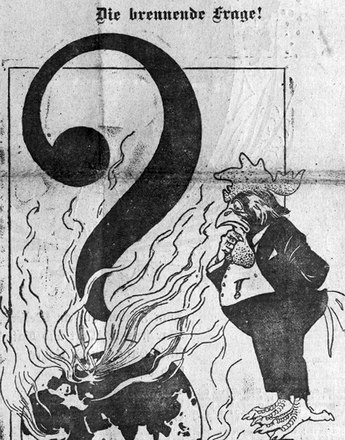-

Delegation of members of Sokol, the Czech National Gymnasts Association, in front of the Austro-Hungarian Corps Command in Prague, photo from Wiener Bilder, issue of 24 November 1918
Copyright: ÖNB/ANNO
Partner: Austrian National Library -

The Bohemian Lion rips apart the old Austrian flag with the double eagle, published by J. Plichta, Prague (based on a motif by B. Kozina), after 1918
Copyright: Schloß Schönbrunn Kultur- und Betriebsges.m.b.H. / Objekt aus der Sammlung Dr. Lukan
After consensus had been achieved in Czech national society on overcoming the heteronomy, the task now was to take concrete steps for change. But the plans of the political leaders were thwarted by the dizzying momentum of events.
“We are breaking our chains for ever in which the faithless, foreign, immoral Habsburgs have tormented us. We are free!”
By the end of October 1918, signs were multiplying that the Imperial-Royal Army was shortly before collapse. The presidency of the Czechoslovakian National Committee resolved to meet the Czechoslovakian government-in-exile in Geneva – acknowledged by the Western Allies as sole representative – with the plan of coordinating further steps.
However, in the meantime the situation in Prague was developing its own momentum: on 28 October 1918 it was reported that the emperor had sent President Wilson a note according to which Austria-Hungary would accept all conditions for an armistice. The first red-and-white flags were hoisted in Prague – the colours of Bohemia. Without waiting for the actual announcement of the end of the war, people began to gather on St Wenceslas Square. Soldiers and policemen ripped off the insignia with symbols of the Imperial-Royal Monarchy from their uniforms and replaced them with the Czechoslovakian cockades in red, white and blue. The first incidents erupted: the incensed crowd removed the double eagle and other Austrian national emblems from public buildings.
On St Wenceslas Square, under the monument of the patron of Bohemia, St Wenceslas, a group of politicians – who no doubt happened to be there by chance – spontaneously proclaimed independence and the founding of the “Czecho-Slovakian State”.
The members of the National Committee remaining in Prague, which saw itself as the sole organ of the nation, were faced with a fait accompli. The impending escalation led to hectic activity among the functionaries. An official text proclaiming independence was formulated at breakneck speed. This was deliberately kept vague, since the connection to the Czechoslovakian exile government in Paris was difficult and the Prague actors did not wish to pre-empt the results of negotiations with the Allies.
What mattered now in Prague above all was to gain control over the organs of government. Members of the National Committee moved into the Imperial-Royal Governor’s office and the Military Command headquarters of the Prague Garrison, demanding that the officials there hand over their powers of administration. The representatives of Austrian state power were well-nigh paralysed. There was no resistance, the transfer of power took place as a coup de main and free of violence. In order to prevent chaos and rioting and to pacify the masses surging through the city, military bands were instructed to parade through the streets. The plan worked, and the people marched singing through the city. The peaceful coup d’état had succeeded.
Translation: Abigail Prohaska
Bihl, Wolfdieter: Der Erste Weltkrieg 1914–1918. Chronik – Daten – Fakten, Wien/Köln/Weimar 2010
Hoensch, Jörg K.: Geschichte Böhmens. Von der slavischen Landnahme bis ins 20. Jahrhundert, München 1987
Gottsmann, Andreas (Hrsg.): Karl I. (IV.), der Erste Weltkrieg und das Ende der Donaumonarchie, Wien 2007
Křen, Jan: Dvě století střední Evropy [Zwei Jahrhunderte Mitteleuropas], Praha 2005
Kučera, Rudolf: Muži října 1918. Osudy aktérů vzniku Republiky Československé [Die Männer des Oktobers 1918. Schicksale der Akteure der Entstehung der Tschechoslowakischen Republik], Praha 2011
Pacner, Karel: Osudové okamžiky Československa [Schicksalhafte Momente der Tschechoslowakei] (3. Aufl.), Praha 2012
Šedivý, Ivan: Češi, České země a velká válka 1914–1918 [Die Tschechen, die Böhmischen Länder und der Große Krieg 1914–1918], Praha 2001
-
Chapters
- Delenda Austria – Austria must be destroyed!
- The aim of state independence: from Utopia to a programme for the masses
- Preparing for the Coup
- The Day of the Coup: 28 October 1918
- The Founding of Czechoslovakia
- The Czechoslovakian Republic as Successor State to Austria-Hungary
- The Czechoslovakian Legions
- The Fall of the Symbols of Habsburg Rule




